intemperie [Spanish noun, with adjectival and adverbial variants]: (1) the great outdoors and experiences of life in the elements; (2) “roughing it” as one might do sleeping under the stars or going camping; (3) foul, anomalous weather marked by extreme or unusual atmospheric conditions; (4) acute weather events that make individuals greatly conscious of their presence in the world; (5) the experience of utter desolation, isolation, or nothingness reinforced by the overwhelming powers of nature; (6) climactic events or changes that poetically resonate or conflict with human emotions and the soul; (7) noticeable changes in weather and climate caused by humankind’s intentional or unintentional actions; (8) the manner in which nature serves as a potent catalyst for memory, nostalgia, and reflection; (9) a term derived from the Spanish word tiempo that may simultaneously reference climate and chronology; (10) a rhetorical reference to the disparities between Naturalistic and Romantic visions of nature, its functions, and its interactions with humankind.
These myriad definitions of intemperie are the consequence of my quest to have Spanish speakers in Argentina—from rural and urban backgrounds, from various age groups, and from various cultures of the Americas—define a seemingly simple word. I was looking for what it means to them, what currency it maintains in popular culture, and how someone unfamiliar with its usage might better grasp its significance. Reflecting beautifully the ability of the Spanish language to embrace semantic pluralism and to celebrate those rhetorical ambiguities and slippages that might otherwise ossify in translation to English, the term intemperie serves as an intriguing thematic point of departure for the 2009 Biennial of the End of the World held in Ushuaia, Argentina. The biennial, now in its second iteration, relied on forty-two artists—as well as its proximity to what is arguably the last geographic frontier, the Antarctic—to engage with the uneasy interactions between humankind and the environment.
Eschewing cryptic, overly generalized, or incomprehensible biennial themes that often fail to plumb the diversity of contemporary artistic expression, chief curator Alfons Hug employed the single word, intemperie, as a verbal illustration of how nature invites a range of collective and individualized interpretations. We might all agree that the sun shines on a particular day or that the rain has fallen ceaselessly over a ruined weekend, but according to Hug the resulting emotions, conversations, and memories that such events trigger are often unpredictable and inconsistent; thus, this biennial exalts both the ever-present Derridean “play” in language and its powerful, enduring effects on the visual, aural, and spatial concerns of the art world.1
Hug initially describes the weather in his curatorial statement as a “kind of second skin” that once mediated and legitimized the self, whilst helping human beings to “feel part of a greater order within nature.”2 Yet, weather has moved beyond these heavily Romanticized premises and become decidedly complex when yoked to politics, culture, contemporaneity, and the constraints of linguistic expression. Hug’s aptly chosen title not only illustrates Derrida’s assertion that “language bears within itself the necessity of its own critique,”3 but also alludes to the rich and varied contemplations of intemperie proposed by artists, subsequently experienced by viewers, and ultimately reconciled with the peculiarities of the world’s southernmost populated city.
As climate change pervades contemporary discussions about environmentalism and illustrates its more activist underpinnings of late, Hug’s exhibition tracks the interesting trajectories that conceptualizations of nature have taken over time—beginning with a nostalgic nod to German Romanticism’s philosophical synchronization of brooding human thought and the great outdoors to Naturalism’s indifference to human determinism, from the scientist’s meteorological and scientific explanations of climate to the artist’s internalizations of it as a timeless byproduct of more spiritual, ceremonial, and metaphysical concerns. After all, tiempo (the Spanish etymological root for the term intemperie) references both the atmospheric and the chronological, generating what Hug describes as a “happy symbiosis” of time and experience that is at the core of all the biennial’s most memorable works. Just as nineteenth-century Romantic artist Caspar David Friedrich noted, “[t]he artist should paint not only what he sees before him, but also what he sees within him,”4 Hug’s reliance on the slipperiness of intemperie as an organizational principle of the exhibition poetically explains the representational variations put forth by his selected artists: as the weather changes, so must the artist’s internalizations of it. Perhaps more important still are viewers’ readings of those diverse artistic propositions that alternatively expose nature as a sublime, localized phenomenon and a looming, global catastrophe—prompting responses that can range from quiet reflection to aggressive radicalism.
Ushuaia’s celebrated status as the city at the “end of the world,” as well as its apparent lack of cosmopolitanism that mega-exhibitions frequently demand from their localities, might seem to make it an unlikely location for a contemporary art biennial. The capital of the Tierra del Fuego province, Ushuaia is a pancreas-jarring three hour flight from Buenos Aires and nestles between the Martial mountain ranges and the Beagle Channel—named after the ship that famously carried Charles Darwin to explore this remote area in 1833. Darwin once believed this part of the world and its extinct Yámana population were the “missing links” in his evolutionary theories and that the supposed primitivism of the region might actually hold the key to phenomena that “advanced” Western science had failed to explain. So, while the Biennial of the End of the World might at first be described as an underdog compared to its larger siblings in Venice, São Paulo, and Kassel, its curatorial team embraced the “missing links” of the contemporary world of biennials: a sense of intimacy between artwork, viewer, and locale; a conceptual and material forthrightness based more on the development of ideas than spectacularity; and an ongoing awareness of the biennial as a critical nexus between local and global concerns. It follows that Hug’s curatorial assistant, Paz Guevara, described the Biennial of the End of the World as the isolated region’s visible declaration of “its right to the contemporary.”5 Indeed, the Biennial has served as a compelling contra-biennale of sorts—relying less on the traditional glitz of catalogues and cocktails and more on artist-community collaborations, grassroots organizational efforts, word-of-mouth advertising, and good will as the fundamentals in its programming and evolution. Unlike larger biennials that rely on host cities’ existing museological infrastructures, the Biennial of the End of the World functions in a part of the world that did not have its first historical art museum until 2000. Thus, the Biennial operates more centrifugally—moving audiences beyond traditional arts-related centers into unlikely architectures and unassuming spaces of the small city.6 Such reliance on a range of venues produces intriguing backdrops for new readings and contextualizations of contemporary practices and revitalized mappings of the city and its unusual histories and unfamiliar traditions.
The first of these unlikely places is the Antigua Usina—a dark, dank ex-electrical substation still reeking from the diesel once used to power its now-inadequate turbines—which resonates beautifully with the small array of works installed there. The substation—still glistening from the oil, dirt, and soot that blanket the generators—conjures an inarguable vision of contamination and environmental degradation that contrasts spectacularly with German artist Thomas Rentmeister’s pristine Plastiksturm (2009), a seemingly innocuous sculpture assembled from pure-white plastics, PVC scraps, and sticky silicone caulk. Despite the apparent lack of correspondence between the “clean” artwork and its grimy surroundings, Rentmeister establishes eerie connective tissues between his piece and its immediate environment—subtly illustrating that environmental damage is just as much a function of the beautiful as it is of the ugly. Similarly, Rentmeister magnifies the dissonances between his work and its spatial context by attaching a mammoth woven ball of yarn to one of the armatures of the idle generator in his installation, Sara (2009). The pastel-shaded fibers convincingly reference actual and implied tensions between domesticity and industry, masculinity and femininity, function and purposelessness.
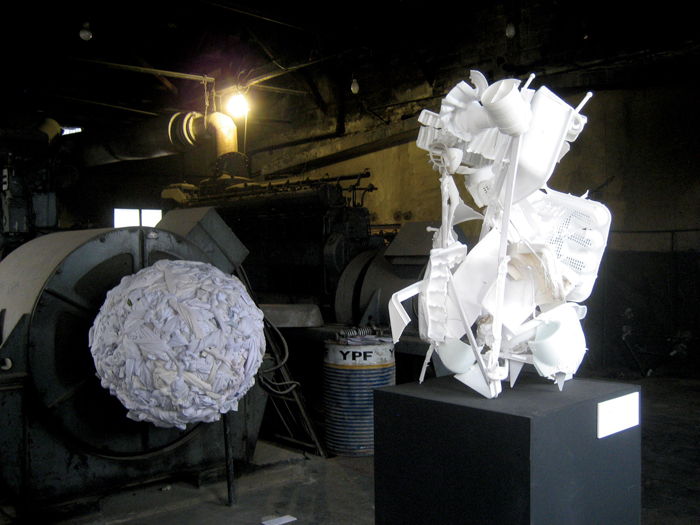
Thomas Rentmeister, Sara, 2009 (left) and Plastiksturm, 2009. Installation view, mixed media. Courtesy the artist. Photo: Royce W. Smith.
Chen Jiagang’s photographic and film works comparably expose struggles to define contemporary beauty, hope, and innocence as states of being necessarily canvassed against China’s “Third Front” and its associated industrialization, harsh working conditions, thick pollution, cultural isolationism, and militaristic secrecy. Chen’s representations of colorfully dressed, smiling young girls—symbolic of as-yet-unrealized dreams and aspirations in “New China”—are the foils to urban blight. Their fashionable attire alternatively corresponds to the chroma of rubbish scattered in the riverbeds where they stand and clashes spectacularly with the monotonous grays and browns of belching factories where they inexplicably linger. While the Biennial did not include Chen’s actual photographs, Hug’s decision to showcase a video documentary of the artist’s creative process, Smog from our History: Documentary of Chen Jiagang’s ‘Third Front’ (2008), interestingly reveals the artist’s use of photography to document and to critique what he calls the “re-reality” of contemporary China.7 Chen’s willingness to re-inhabit the diseased landscape mirrors the documentary work of the venue’s other artist, Simon Faithfull, whose video Stromness (2005) serves as a rare view into a long-abandoned Antarctic whaling station now taken over by a thriving colony of seals that writhe in and out of once-domestic spaces and empty warehouses. Much as the sundry definitions of intemperie can illustrate the acutely individualized perceptions of environment, the seals’ unlikely land grab showcases the perpetually changing dynamics between humankind and nature. Paralleling the artist’s almost contradictory view of Antarctica as expansive and claustrophobic—a world of nothingness illuminated with disorienting light of exceptional intensity—Stromness captures nature’s reclamation of human artifice, as snowy gales rush through shattered window panes and buildings collapse under the weight of their disuse and forgottenness.8 It bears mentioning that the conditions for viewing these works in the Biennial often resonate with their content—as the penetrating winter cold interrupts the traditional concentration one usually employs in the museum to enjoy the artwork with the realities of physical discomfort and the changing effects of Ushuaia’s unstable weather patterns. As teeth chatter and limbs begin to unconsciously spasm in an effort to keep warm, artistic production and perception in this Biennial often occur at the mercy of intemperie.

Guillermo Srodek-Hart, Jackson, 2008. Stills from color video with sound. Duration: 3:43. Courtesy the artist. Photo: Royce W. Smith.
Such differentials in temperature mark the Biennial’s entrance into Ushuaia’s Presidio—a warmed and expansive foyer prefacing the deteriorating prison cells, dirt-encrusted windows, and drafty corridors of a formal penal establishment dating from the 1920s. German artist Michael Sailstorfer’s work, Hoher—Besuch—Ushuaia (Visita Oficial Ushuaia) (2009), echoes through the cell block with the amplified sound of a lone ceiling fan positioned in the foyer outside the penitentiary—a nod to the repetitive, monotonous, and unexceptional activities that once constituted prison life here. The inescapable nature of the noise eventually transforms from eerie and curious to distressing and wearisome—its tediousness thankfully countered by the levity of new video works by Argentinean artist Guillermo Srodek-Hart. Most memorable is his piece Jackson (2008)—a contemporary, Joseph Beuys-like documentation of an intrusion into a goat enclosure in which the needs of food, security, and companionship serve as fascinating bridges between the species. While Jackson, the goat, initially maintains a precarious and tentative coexistence with Srodek-Hart, the goat eventually spoons with the artist during an afternoon nap and showcases an unexpected-yet-cozy alliance—a strange elaboration of the shifting human/animal dynamics explored in Simon Faithfull’s Stromness. Just as Jackson exposes an interaction with animals most likely foreign or unthinkable to most viewers, Srodek-Hart cleverly juxtaposes his caprine love-in with a gruesome act of butchery in the aptly titled video Butchery (2008), revealing the violent cracking of joints and ripping of tendons that precedes most individuals’ experience of “meat” as a tidy, bloodless, cellophane-wrapped supermarket encounter. The ready-to-roast carcass that concludes the film is the clean coda to the carnal scenes before it—entrails dumped to the ground and pecked at by chickens, blood running from the gut in unchecked rivers, fur unceremoniously stripped from the animal and tossed to the side. Srodek-Hart’s counterpoint to Jackson interestingly casts “butcher” as both verb and adjective—resonating well with the exhibition’s pluralistic relationship to intemperie. While trained as a photographer, Srodek-Hart is particularly adept at both perpetuating and utterly dismantling the romanticized views of nature and its myriad interactions with human existence through his time-based performances and documentations included in the Biennial.9
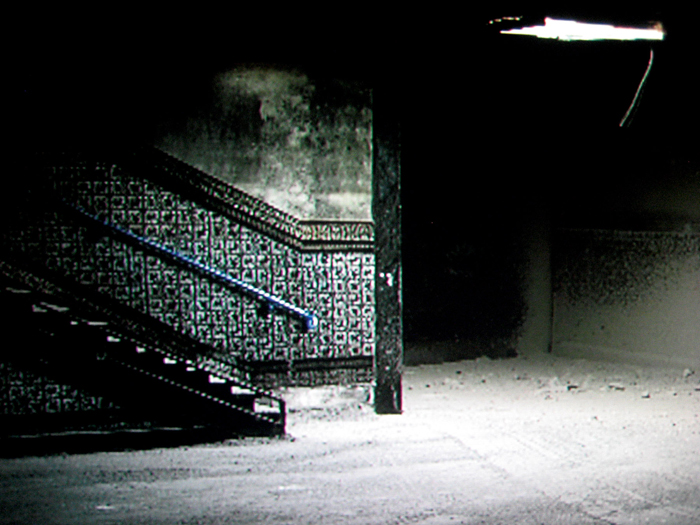
Hugo Aveta, Subte, 2009. Still from color video without sound. Duration: 30:00. Courtesy the artist. Photo: Royce W. Smith.
Other notable works located in adjoining blocks of the Presidio include Hugo Aveta’s analogue and time-based interrogations of space and place. In Subte (2009), a photograph of an empty, dilapidated subway station is installed opposite a time-based video of the same environment in which the interplay of light, movement, and sound add further dynamism to an otherwise banal location. One hears rustlings and voices, shadows pass hauntingly, and gusts of wind blow around dust and forgotten papers, but the viewer sees no bodies or occupations of space. The place is full of life but devoid of it or, perhaps, denied it—leaving one with contradictory elaborations of an environment that both reveals and conceals its purpose and history. Aveta’s concomitant meditations on existence, disuse, nostalgia, and loss correspond well to Laura Glusman’s Banquito (Bench) (2007)—a disconcerting engagement with the drowned landscape devoid of any human presence, yet full of subtle evidence that nature is a force ultimately greater than human will. As waves peacefully lap beyond their banks with a mesmerizing sound, they engulf a lone park bench and allude to the odd coexistence of tranquility and crisis. In a similar fashion, Esteban Álvarez’s video, Economic Project for a Fairer Ecology (2009), straddles the world of performance and documentation as the artist openly wonders how to transform one of Argentina’s greatest tourist attractions, Perito Moreno Glacier in El Calafate, into an agent of political, social, and economic change. His suggestions, posed as he downs a bottle of Jack Daniels cooled with glacial ice cubes, include transferring the glacier’s pure water into Buenos Aires’ contaminated Riachuelo, shaving off the top layer of the glacier to “democratize” the ice and make it more accessible to the public, and dynamiting the glacier at strategic intervals to give tourists the spectacular calving of ice they hope to capture on their cameras. The capstone to his ruminations, Álvarez’s drunken ascension to one of the glacier’s peaks and failed attempts to plant a flag of conquest atop it only underscore the futility and ridiculousness of his proposals and the ultimate domination of nature over human endeavors.
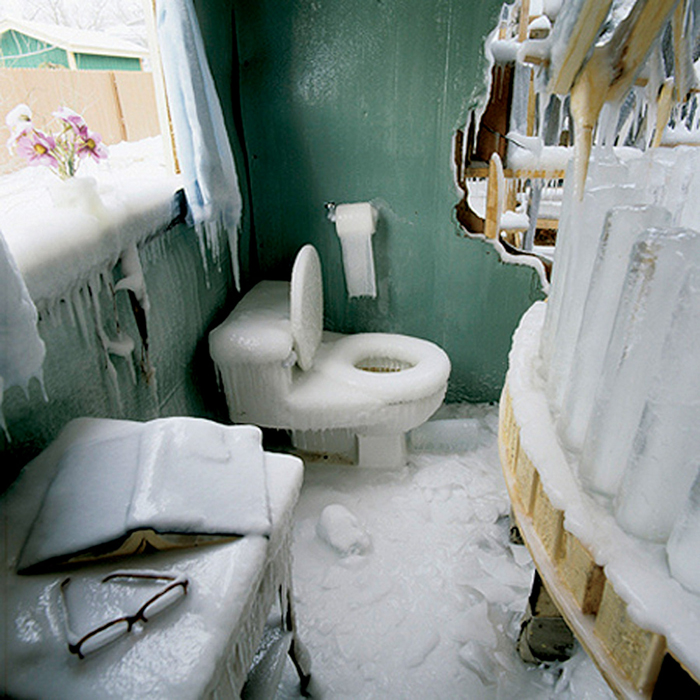
Chris Larson, Deep North, 2008. Stills from color video with sound. Duration: 8:15. Courtesy the artist and Magnus MüLler, Berlin.
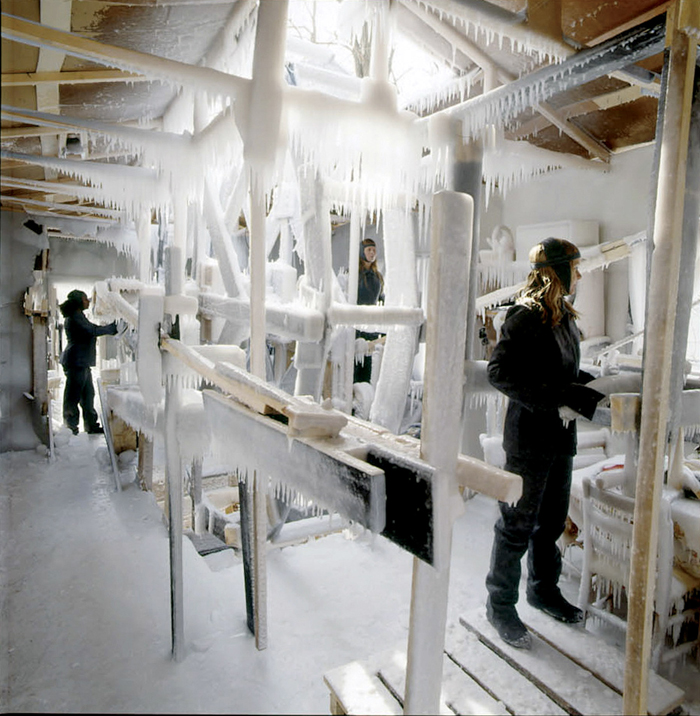
Chris Larson, Deep North, 2008. Stills from color video with sound. Duration: 8:15. Courtesy the artist and Magnus MüLler, Berlin.
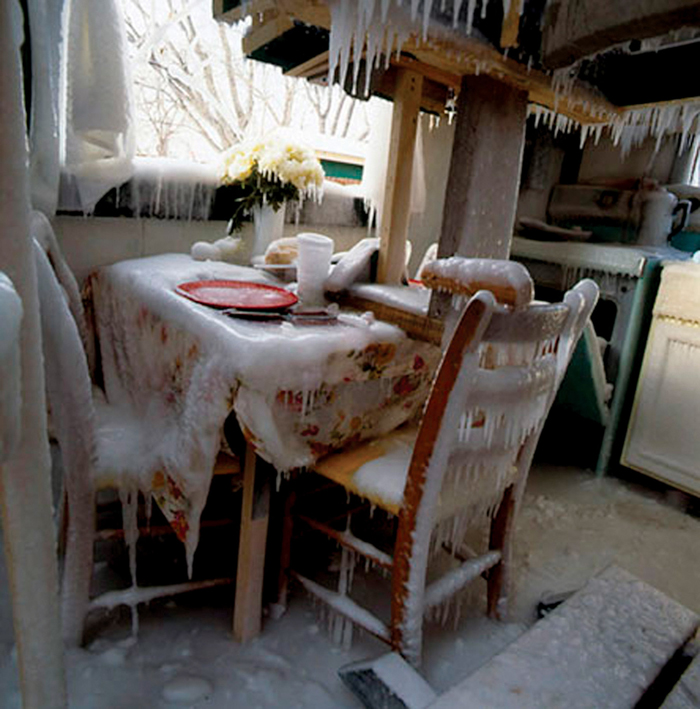
Chris Larson, Deep North, 2008. Stills from color video with sound. Duration: 8:15. Courtesy the artist and Magnus MüLler, Berlin.
Perhaps the most revealing illustrations of intemperie culminate at Ushuaia’s ex-airport hangar in which cube-like structures screen a variety of video works that delve differently into the complexities of the elements: earth, air, fire, and water. Chris Larson’s Deep North (2008) stages fictional-yet-dire hypotheses of future domestic spaces—kitchens, bathrooms, and bedrooms—sepulchrally encased in thick layers of ice. Within Larson’s self-fashioned igloo, created by cutting the roof off a house in Minnesota and repeatedly dousing it with jets of water, two women operate a wooden ice-making machine, oblivious to the pointlessness of their labor and their subsumption within the grand narrative of Naturalism. The futility of humankind’s resistance to the environment is also seen in Laura Glusman’s Nado y Nada (2004)—a work whose filmed figure swims against the currents of a turbulent river but never progresses beyond her initial position in the water. Similarly, Guido van der Werve’s Nummer acht: Everything is going to be alright (2007) documents a lone man walking deliberately across an ice-covered body of water, only a few treacherous steps in front of an ice-breaking vessel that follows him relentlessly, perpetually threatening the stability of his footing. While these works forge a type of “neo-sublime” by candidly laying bare the precariousness of humankind’s existence as it resists or confronts the elements, other works, such as Reynold Reynolds and Patrick Jolley’s Burn (2002) render the sublime as a function of disconcerting passivity when action and escape would be, in the eyes of most, decidedly called for. For example, as a domestic space catches fire, its occupants calmly swat at the flames and carry on with their everyday activities—leaving one man to continue with the reading of his smoldering newspaper and a woman to confront her seemingly heavy and mournful thoughts amid the melting plastics of a cheap refrigerator set ablaze. While pyromaniacal at first glance, the video’s allusions to the burning of hopes and memories, living spaces, and flesh gnaw pointedly at viewers’ defensive instincts and protectionist intuitions: Who would wantonly set such an inferno? Who would willingly remain within a world so quickly and ruthlessly burning to the ground? Burn powerfully locates the true terror of the contemporary sublime and its linkages to humanity and intemperie in having done too little too late, and having done too much in a world often characterized by its excess and uncontrollability.
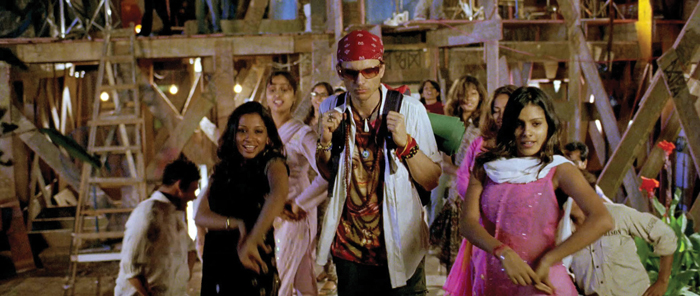
Julian Rosefeldt, Lonely Planet, 2006. Stills from 35 mm film with sound transferred to DVD. Duration: 16:18. Courtesy the artist and Max Wigram Gallery, London.
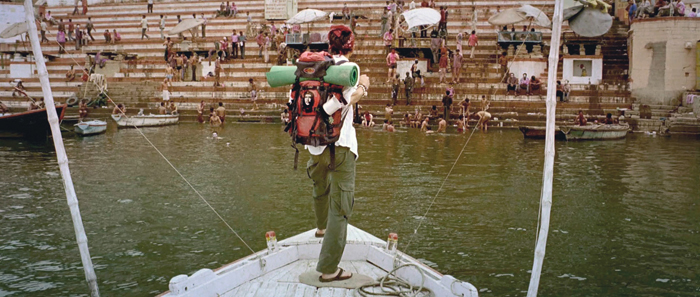
Julian Rosefeldt, Lonely Planet, 2006. Stills from 35 mm film with sound transferred to DVD. Duration: 16:18. Courtesy the artist and Max Wigram Gallery, London.
Other video works exhibit the incredulity of ignorance in far more humorous and clandestine ways. Julian Rosefeldt’s Lonely Planet (2006) follows the exploratory journeys of the modern Che-festooned backpacker in India who does not immerse himself in the rich significances of culture, but rather indulges in its touristic superficialities: “wearing culture” by means of a souvenir t-shirt, awkwardly imitating Bollywood dance choreography, and standing at the bow of a boat crossing a river in a Magellan-like posture of colonialist “discovery.” Yet, an on-screen Indian audience views (and often laughs at) his cultural disorientations as a filmic spectacle in its own right—their watching of this movie-within-a-movie unearths the dizzying complexities of foreignness. Not only is the “I” encountering the “Other,” but the “I-as-Other” encounters the “Other” who encounters the “Other-as-I.” And so the film alternates between layers of discovery and misinterpretation, of seeing and being seen, that are crucial to the politicization of the visual, the development of cultural sensitivities, and the perpetuation of stereotypes and prejudices.
Ultimately, the 2009 Biennial of the End of the World looks even further southward to the Antarctic—a place where the politics of museums, values of currency, histories of aggression and acquiescence, and nomenclatures of First- and Third-Worldliness hold no sway, to a “classic no-man’s land [that] belongs to no one and therefore to everyone.”10 Such a frozen, vastly unexplored territory surely is the last Friedrich-like frontier of the unknown—pristine and virginal, as Hug’s curatorial observations suggest, but also threatened and vulnerable as the world we know now becomes increasingly hostile, toxic, uninhabitable, or unprosperous. As eyes of the future may well turn to Antarctica to satiate global appetites for water, food, and oil, Hug also reminds us tragically that at all points in human history, the far South’s universal currents of “purity, clarity, peace, and spirituality”11 have been trumped by the power, domination, and self-interest that illustrate the primacy of certain cultures and localities. It is in Ushuaia and beyond to the Antarctic—away from the gravitas and familiarity of the Western contemporary art world—that this Biennial has successfully shown to us the error of our ways and engaged with the dangers and perils that loom should we fail to change them.
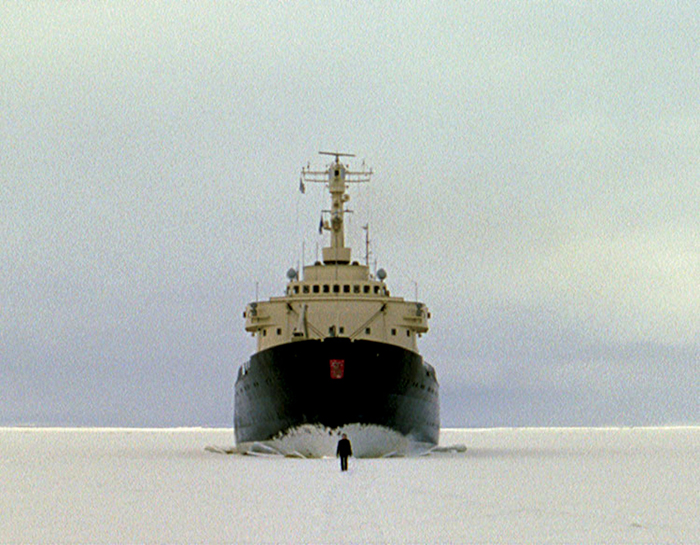
Guido Van Der Werve, Nammer acht: Everything Is Going to Be Alright, 2007. Still from 16mm film transferred to Hd video. Duration: 10:09. Courtesy the artist.
Royce W. Smith is Assistant Professor of Modern & Contemporary Art History at Wichita State University. He is currently completing a monograph on contemporary festivals and biennales, entitled Biennale/Anti-Biennale: Situating Contemporary Art and its Histories in the Age of the Mega-Exhibition, due to be published in 2010. He is also teaching an overseas seminar in Fall 2009 that will help students cross-culturally compare the exhibition strategies of the Venice Biennale and Istanbul Biennial.
